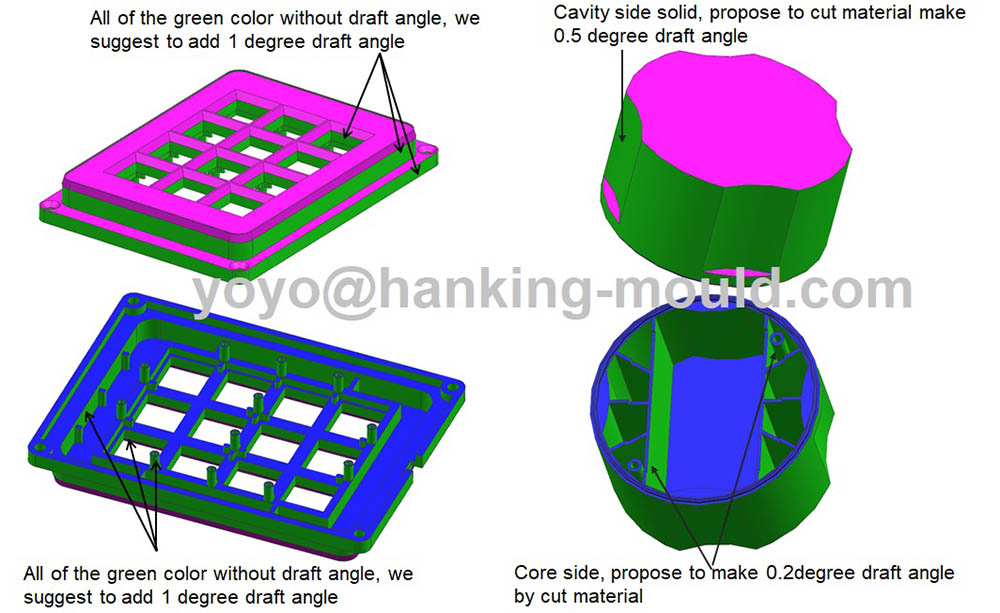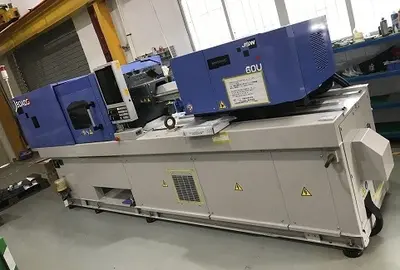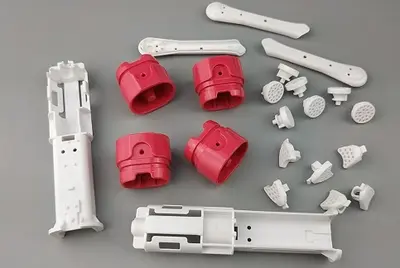

•What is draft in plastic injection molding?
•Reasons why plastic injection molded parts need draft
•The ideal draft angle range for plastic injection molded parts
•Incorporating draft in the design process
•Case Studies: Real-world examples of draft implementation
Before we delve into the reasons why draft is essential, let's define what draft means in the context of plastic injection molding. In simple terms, draft refers to the slight taper or inclination given to the walls of a molded plastic part. This taper allows for a seamless ejection of the part from the plastic injection mould, ensuring a smooth and efficient plastic products manufacturing process.
During the ejection process, which occurs after the part has solidified within the mold, there is a risk of damage if no draft is present. Imagine trying to remove a part with vertical walls from a mold – it would require significant force, leading to potential deformations or even breakage.
By incorporating draft into the design, we can mitigate these risks and ensure a damage-free ejection. The slight incline of the walls allows for a smoother release from the plastic injection tooling, reducing the chances of damage to the part.
A seamless ejection is crucial for maintaining a high production speed in plastic injection molding. Without draft, the resistance encountered during ejection can significantly slow down the entire process. The absence of draft angles results in increased friction between the part and the injection mold, leading to sticking and potential part deformation.
Draft angles act as a lubricant, facilitating a smooth release of the part from the plastic injection mould. This not only improves production efficiency but also enhances the overall quality of the molded parts.
When it comes to manufacturing, cost-efficiency is always a top priority. Plastic injection molding is no exception – minimizing costs is crucial to maintain competitiveness in the market. The inclusion of draft angles plays a definitive role in reducing plastic manufacturing costs.
One significant factor influencing costs is material waste. Without proper draft angles, more material is required to fill the plastic injection mold, resulting in increased waste. By incorporating draft into the design, we can optimize the material usage, reducing waste and lowering costs.
Furthermore, the cycle time – the time it takes for a mold to complete one full cycle – is influenced by how smoothly the parts are ejected. With draft, the ejection process is efficient and rapid, leading to shorter cycle times and improved cost efficiency.
Now that we understand the importance of draft angles, let's explore the factors to consider when determining the ideal draft angle for your injection molded plastic products.
The ideal draft angle depends on several factors, including the part's geometry and the material being used. It is crucial to consider these elements to ensure proper functionality and ease of manufacturing.
Additionally, the wall thickness of the part plays a role in the selection of the draft angle. Thicker walls may require a larger draft angle to facilitate smooth ejection.
Although the ideal draft angle may vary depending on specific part and application requirements, there are some general recommendations to keep in mind.
Common draft angles used in injection molding range between 0.5 to 3 degrees. However, it's important to note that draft angles exceeding 5 degrees can complicate the molding process, potentially leading to increased costs and risks of defects.
When determining the appropriate draft angle, it's essential to balance functionality with manufacturability and cost considerations. Consulting with experienced injection mold makers and engineers can provide valuable insights into optimizing the draft angle for your specific needs.
Achieving the desired draft angle requires collaboration between designers and mold engineers. Effective communication is key to ensuring that the design intent translates into a functional part with appropriate draft angles. Early involvement of plastic injection mold manufacturers in the design process facilitates a seamless integration of draft angles.
An open exchange of ideas and information between both parties helps overcome potential challenges and ensures the successful implementation of draft angles in the final injection molded plastic parts.
Designers play a crucial role in incorporating draft angles into their designs effectively. Several design techniques can be employed to achieve the desired draft. For example, adding a taper to vertical walls or incorporating fillets can help create the necessary draft angles.
To aid in the design process, designers can also utilize draft analysis tools and software. These tools provide insights into areas that require draft angles and help validate the design before moving onto the mass production stage.
Let's take a moment to explore some real-life examples of successful draft implementation in plastic injection molding. These case studies highlight the impact of proper draft angles on functionality, efficiency, and cost savings.

Case Study 1: We suggest that customers introduce a 1 degree draft angle to minimize part damage during the ejection process. This not only improves the quality of the finished product, but also reduces production costs by eliminating scrapped parts.
Case Study 2: We suggest that customers implement appropriate draft angles in injection molded parts to assist in ejection and shorten cycle time. By ensuring a smooth ejection, they achieved faster production rates and significant cost savings.
As we wrap up our exploration into the world of draft angles in plastic injection molding, we hope you now have a better understanding of their importance in achieving optimal functionality and cost efficiency in molded parts.
Remember, incorporating appropriate draft angles is crucial to prevent damage, facilitate smooth ejection, and reduce manufacturing costs. By collaborating with molders during the design process and following recommended guidelines, you can create high-quality injection molded parts that meet your specific needs.
So, if you want to design a perfectly injection molding plastic product, take some time to discuss with excellent mold designers who usually come from plastic injection mold manufacturers - HanKing Mould has these designers and engineers, please contact us now, send email to yoyo@hanking-mould.com, we will give you best proposal.






 Call us on:
Call us on:  Email Us:
Email Us:  No.23, XingYi Road, Wusha Community, Chang'an Town, Dongguan City, Guangdong Province, China.
No.23, XingYi Road, Wusha Community, Chang'an Town, Dongguan City, Guangdong Province, China.